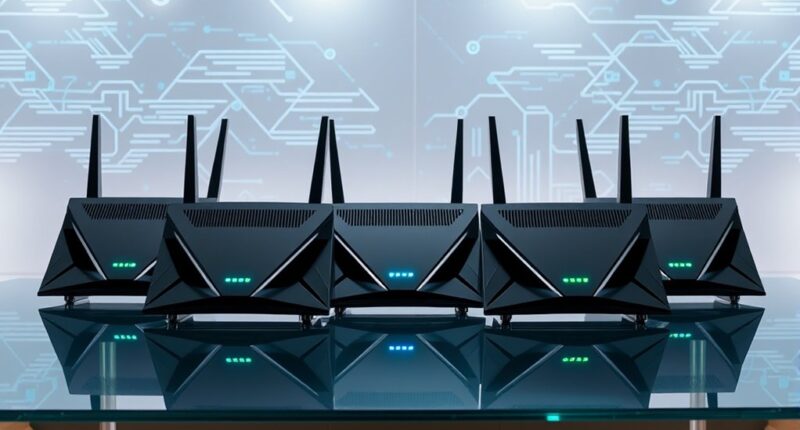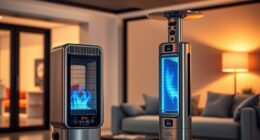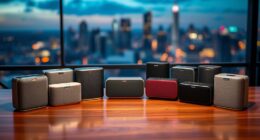If you’re looking for the 15 best Wi-Fi 7 routers of 2025, I recommend exploring options like the TP-Link Archer BE6500, NETGEAR Nighthawk BE9300, ASUS RT-BE92U, and Amazon eero 7, as they offer blazing speeds, extensive coverage, and future-proof features. These routers support high device density, mesh networking, and advanced security. From casual use to demanding smart homes, there’s a model here for everyone. Stay with me to discover the full list and help you pick the right one.
Key Takeaways
- Top Wi-Fi 7 routers offer speeds up to 30 Gbps with advanced features like Multi-Link Operation and OFDMA for ultra-fast, low-latency connectivity.
- Many models support extensive coverage (up to 6,600 sq. ft.) and connect over 100 devices, ideal for smart homes and busy households.
- The best routers include mesh compatibility, easy management apps, and security features like WPA3 and VPN support.
- Future-proof options feature multi-gig ports, support for high-speed internet plans, and compatibility with Wi-Fi 7 devices.
- Leading models cater to various needs, from casual use to demanding gaming and professional workloads, ensuring reliable, high-speed network performance.
TP-Link Archer BE6500 Wi-Fi 7 Router

If you’re looking for a future-proof router that can handle multiple devices with lightning-fast speeds, the TP-Link Archer BE6500 Wi-Fi 7 Router is an excellent choice. It supports the latest Wi-Fi 7 tech like Multi-Link Operation and Multi-RUs, delivering up to 5764 Mbps on the 5GHz band. With a quad-core CPU, dual 2.5 Gbps ports, and six high-performance antennas, it ensures stable, fast connections across a coverage area of up to 2,400 sq. ft. Supporting up to 90 devices, it’s perfect for streaming, gaming, and smart home setups. Plus, its security features and easy setup make it a versatile, reliable choice.
Best For: households and tech enthusiasts seeking a future-proof, high-speed Wi-Fi 7 router capable of supporting multiple devices for streaming, gaming, and smart home applications.
Pros:
- Supports the latest Wi-Fi 7 features like Multi-Link Operation and Multi-RUs for enhanced speed and stability
- Delivers high speeds up to 5764 Mbps on 5GHz and 688 Mbps on 2.4GHz bands with 6 streams
- Covers up to 2,400 sq. ft. and supports up to 90 devices, ideal for busy households and smart homes
Cons:
- May be more expensive than earlier Wi-Fi 6 routers due to advanced technology
- Larger size of 10.6 x 6 x 1.9 inches may require sufficient space for placement
- Requires compatible devices to fully utilize Wi-Fi 7 capabilities
TP-Link Dual-Band Wi-Fi 7 Router Archer BE230

The TP-Link Archer BE230 stands out as an excellent choice for households seeking reliable, high-speed Wi-Fi 7 connectivity. It delivers up to 3.6 Gbps, with 2882 Mbps on the 5 GHz band and 688 Mbps on 2.4 GHz, thanks to Wi-Fi 7’s advanced Multi-Link Operation and increased data capacity. Its 2.0 GHz quad-core processor guarantees smooth performance, while four external antennas with beamforming enhance coverage and signal strength. Dual 2.5 Gbps ports and multiple Gigabit ports support high-speed connections across devices. EasyMesh compatibility, TP-Link Tether app management, and robust security features make setup and everyday use seamless and secure.
Best For: households and small offices seeking ultra-fast, reliable Wi-Fi 7 connectivity for streaming, gaming, and multiple device use.
Pros:
- Supports Wi-Fi 7 with speeds up to 3.6 Gbps for seamless high-bandwidth activities
- Equipped with a powerful 2.0 GHz quad-core processor ensuring stable performance
- Features multiple ports, including dual 2.5 Gbps ports, for high-speed wired connections
Cons:
- Requires a compatible modem for internet connection, which may add to setup complexity
- Larger size may be less suitable for space-constrained environments
- Advanced features might be overwhelming for casual users unfamiliar with networking technology
NETGEAR Nighthawk WiFi 7 Router (BE9300)
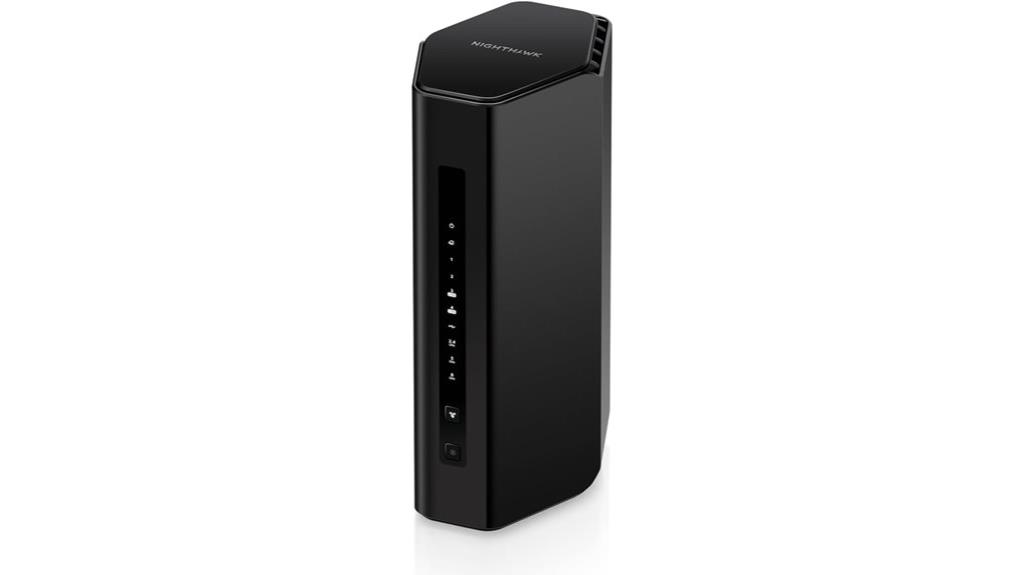
For gamers and streamers seeking lightning-fast internet speeds, the NETGEAR Nighthawk WiFi 7 Router (BE9300) stands out as an excellent choice. It delivers blazing speeds up to 9.3Gbps, perfect for gaming, streaming, and video calls. The tri-band setup supports up to 100 devices and covers around 2,500 square feet with high-performance antennas. It features a 2.5 Gigabit Ethernet port for multi-gig internet plans, though a separate modem is needed. Its sleek design and easy setup via the Nighthawk app make it user-friendly. Plus, built-in security, including NETGEAR Armor, keeps your network protected against threats.
Best For: gamers, streamers, and households needing ultra-fast, reliable WiFi coverage for multiple devices and high-bandwidth activities.
Pros:
- Extremely fast speeds up to 9.3Gbps ideal for gaming, streaming, and video conferencing
- Supports up to 100 devices with tri-band coverage for extensive connectivity
- User-friendly setup and management via the Nighthawk app with enhanced security features
Cons:
- Requires a separate cable modem for internet access, adding to setup complexity
- No built-in cable modem, so not an all-in-one solution
- Designed for use within the U.S. only, limiting international compatibility
TP-Link Tri-Band WiFi 7 Router Archer BE600
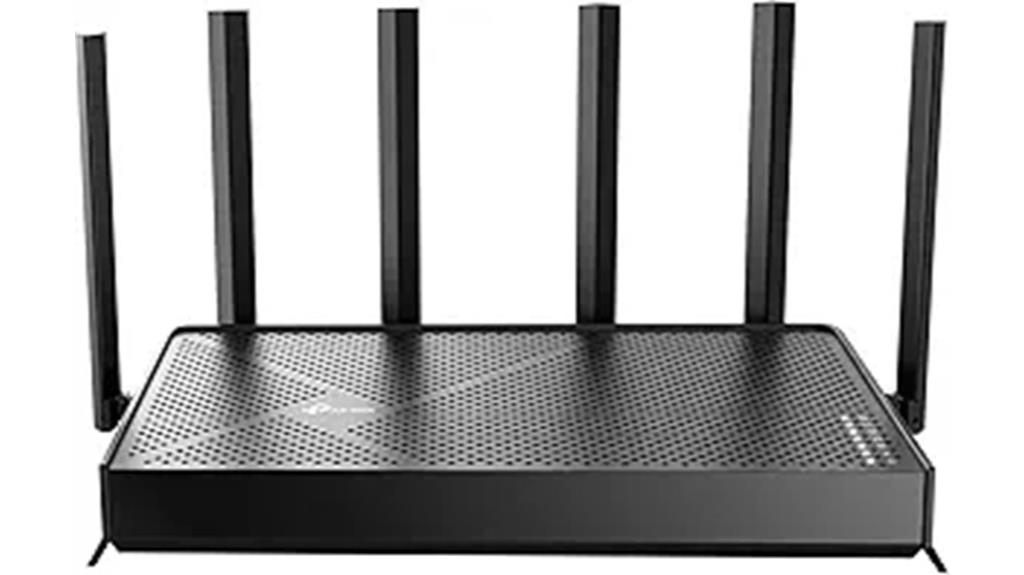
Designed for large households and high-demand users, the TP-Link Tri-Band WiFi 7 Router Archer BE600 delivers exceptional coverage and speed with its advanced tri-band technology. Covering up to 2,600 square feet and supporting 120 devices, it’s perfect for busy homes and smart setups. With a robust quad-core CPU, six antennas, and features like beamforming, MU-MIMO, and OFDMA, it guarantees reliable, fast connections across multiple devices. Its user-friendly setup via the Tether app or web interface, combined with top-tier security like WPA3 and TP-Link’s HomeShield, makes it a future-proof, high-performance choice for demanding internet needs.
Best For: large households and high-demand users seeking ultra-fast, reliable WiFi coverage and robust security features.
Pros:
- Exceptional coverage up to 2,600 sq. ft. supporting 120 devices for seamless connectivity across large spaces
- Advanced WiFi 7 technology with multi-link operation and multi-RUs for maximum speed and efficiency
- User-friendly setup via Tether app and comprehensive security features including WPA3, HomeShield, and parental controls
Cons:
- First availability scheduled for May 8, 2025, which may delay purchase for some users
- Higher price point typical for high-end WiFi 7 routers with advanced features
- Potential complexity for users unfamiliar with multi-band network configurations and advanced security options
TP-Link Tri-Band WiFi 7 Router Archer BE700

If you’re looking to future-proof your home network with lightning-fast speeds and robust coverage, the TP-Link Tri-Band WiFi 7 Router Archer BE700 is an excellent choice. It leverages Wi-Fi 7 technology with Multi-Link Operation, Multi-RUs, 4K-QAM, and channels up to 320 MHz, delivering tri-band speeds of over 11 Gbps. It supports the latest devices like iPhone 16 Pro and Samsung Galaxy S24 Ultra, perfect for 4K/8K streaming, AR/VR gaming, and fast downloads. With a 10 Gbps WAN port, multi-gig LAN options, six internal antennas, and Beamforming, it guarantees seamless, whole-home coverage while maintaining security with TP-Link HomeShield.
Best For: power users and tech enthusiasts seeking ultra-fast, reliable, and extensive home Wi-Fi coverage with the latest Wi-Fi 7 technology.
Pros:
- Tri-band speeds up to 11,528 Mbps support 4K/8K streaming and gaming without lag
- Multi-gig ports, including a 10 Gbps WAN port, for high-speed internet connections
- Six internal antennas with Beamforming ensure strong, targeted whole-home coverage
Cons:
- Higher price point may be a barrier for budget-conscious consumers
- Requires compatible multi-gig modems for full gigabit internet performance
- Setup complexity might be challenging for less tech-savvy users
TP-Link Tri-Band WiFi 7 Router (Archer BE550)

The TP-Link Archer BE550 stands out with its tri-band Wi-Fi 7 technology, making it an excellent choice for households that demand ultra-fast, reliable internet for streaming, gaming, and smart home devices. It supports speeds up to 9.2 Gbps through Multi-Link Operation, with 6 GHz, 5 GHz, and 2.4 GHz bands. Equipped with six antennas, Beamforming, and Wi-Fi optimization, it guarantees stable, high-capacity connections. Full 2.5G ports prepare your network for the future. Easy to set up via the Tether App, it also offers whole-home coverage with EasyMesh, advanced security, and compatibility with Alexa and Google Assistant.
Best For: households seeking ultra-fast, reliable Wi-Fi coverage with advanced security and seamless device connectivity for streaming, gaming, and smart home devices.
Pros:
- Supports Wi-Fi 7 with speeds up to 9.2 Gbps for high-capacity use
- Tri-band design with six antennas and Beamforming for stable, extensive coverage
- Easy setup via Tether App, with compatibility for Alexa, Google Assistant, and EasyMesh
Cons:
- Slightly higher price point compared to dual-band or Wi-Fi 6 routers
- Large size may require ample space for optimal placement
- Limited detailed information on external antenna specifications
NETGEAR Nighthawk WiFi 7 Router (RS90)
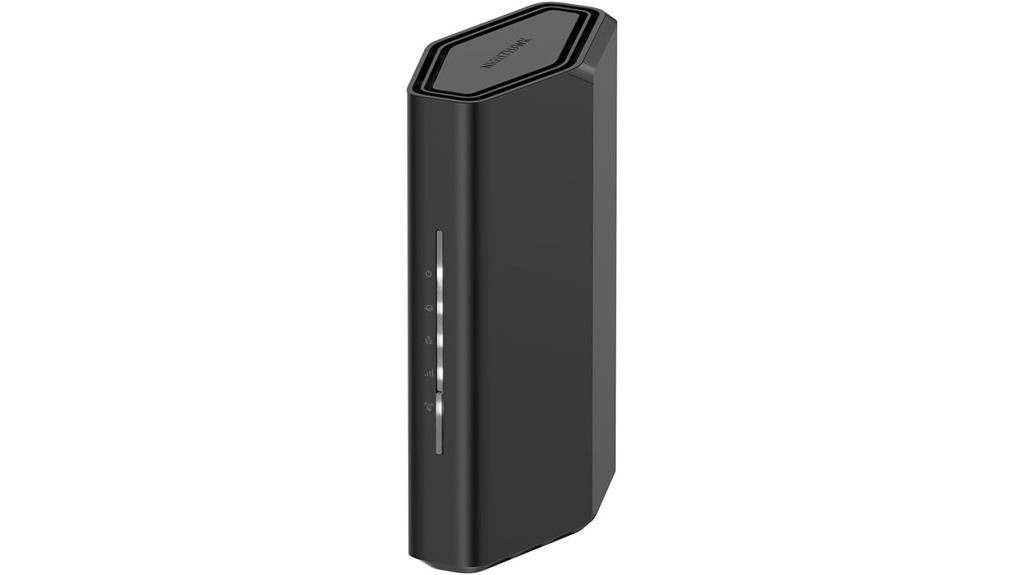
For those seeking a high-performance Wi-Fi 7 router that can handle multiple devices seamlessly, the NETGEAR Nighthawk RS90 is an excellent choice. It offers speeds up to 3.6 Gbps, making it perfect for gaming, streaming, and video calls. Its sleek design and high-performance antennas provide coverage up to 2,000 sq. ft., supporting up to 50 devices simultaneously. The router features a 2.5 Gig internet port for multi-gig speeds, though you’ll need a separate modem. Easy to set up via the Nighthawk app, it also includes advanced security features like NETGEAR Armor, ensuring your network stays protected.
Best For: those seeking a high-speed WiFi 7 router capable of supporting multiple devices for gaming, streaming, and video conferencing in a large coverage area.
Pros:
- Delivers ultra-fast WiFi speeds up to 3.6 Gbps, ideal for demanding online activities
- Supports up to 50 devices simultaneously, ensuring reliable connectivity for many smart devices
- Easy setup and management via the Nighthawk app with enhanced security features like NETGEAR Armor
Cons:
- Does not include a built-in modem; a separate modem with coax input is required for internet access
- Designed primarily for use in the U.S., limiting its functionality in other regions
- The high-performance antennas and coverage may be overkill for small or basic home networks
TP-Link Dual-Band WiFi 7 Router Archer BE260

Designed for home users seeking fast, reliable Wi-Fi without the complexity of 6GHz networks, the TP-Link Dual-Band WiFi 7 Router Archer BE260 leverages cutting-edge Multi-Link Operation (MLO) and Multi-RUs technologies to deliver blazing speeds of up to 4324 Mbps on the 5GHz band. It offers speeds of 688 Mbps on the 2.4GHz band with five streams, perfect for streaming 4K/8K content, gaming, and fast downloads. With a 2.5 Gbps WAN port, multiple LAN ports, and coverage up to 2,400 sq. ft., it supports 80 devices with strong, focused signals using Beamforming technology. Easy to set up and extend, it’s an excellent choice for a seamless smart home network.
Best For: home users seeking high-speed, reliable Wi-Fi performance without the need for 6GHz band support.
Pros:
- Delivers blazing speeds up to 4324 Mbps on 5GHz with advanced MLO and Multi-RUs technology.
- Supports extensive coverage up to 2,400 sq. ft. and up to 80 devices with Beamforming technology.
- Easy setup and management via Tether app, with seamless expansion through EasyMesh compatibility.
Cons:
- Does not support the 6GHz band, limiting some future-proofing and peak performance options.
- Requires a compatible modem for internet connectivity, adding an extra setup step.
- Slightly higher cost compared to traditional dual-band routers without Wi-Fi 7 features.
NETGEAR Nighthawk WiFi 7 Router (RS140)

If you’re looking for a high-performance router that can handle multiple devices seamlessly, the NETGEAR Nighthawk WiFi 7 Router (RS140) is an excellent choice. It delivers speeds up to 5.0 Gbps, making it 1.2 times faster than WiFi 6, perfect for gaming, streaming, and smart home devices. Covering up to 2,250 sq. ft. and supporting 80 devices, it’s built for busy homes or small offices. Equipped with high-performance antennas and a sleek design, it enhances coverage and aesthetics. The router’s 2.5 Gigabit Ethernet port guarantees multi-gig internet speeds, providing reliable, future-proof connectivity for all your needs.
Best For: households or small offices seeking a high-speed, reliable WiFi 7 router that can support multiple devices for gaming, streaming, and smart home applications.
Pros:
- Delivers ultra-fast speeds up to 5.0 Gbps, ideal for high-bandwidth activities
- Supports up to 80 devices simultaneously, perfect for busy environments
- Covers a large area of up to 2,250 sq. ft. with enhanced coverage and sleek design
Cons:
- Requires a separate modem for internet access, adding to overall setup cost
- Might be more expensive than WiFi 6 routers with similar coverage and features
- Some advanced features may need technical knowledge to configure and optimize
ASUS RT-BE58U WiFi 7 Router with AiMesh and 2.5G Port
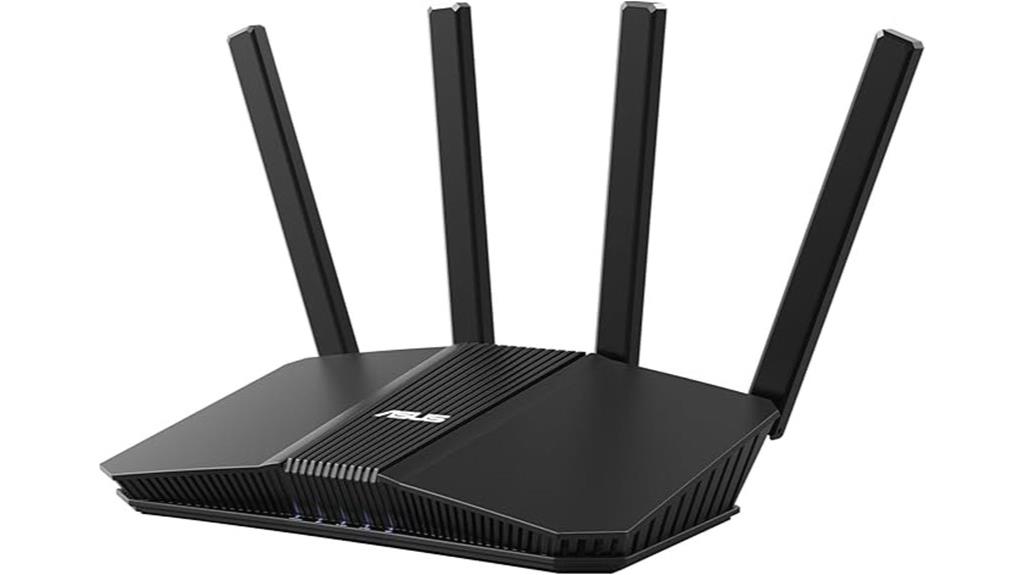
The ASUS RT-BE58U WiFi 7 Router with AiMesh and a 2.5G port stands out as an excellent choice for those needing ultra-fast, reliable internet across multiple devices. It supports WiFi 7 (802.11be), delivering speeds up to 3600 Mbps, thanks to 4096-QAM and Multi-link operation for stable, smooth connections. With versatile WAN options, a USB port for mobile tethering, and four 1G ports plus a 2.5G port, it offers flexible wired and wireless connectivity. Additionally, it supports IoT device management, secure VPN, parental controls, and AiProtection Pro security, making it a future-proof, high-performance router suitable for demanding homes and small offices.
Best For: households and small offices seeking ultra-fast, reliable WiFi 7 connectivity with extensive device management and security features.
Pros:
- Supports WiFi 7 (802.11be) with speeds up to 3600 Mbps for high-performance wireless connections
- Equipped with a 2.5G port and multiple 1G ports for versatile wired connectivity
- Features comprehensive security with AiProtection Pro, parental controls, and VPN support
Cons:
- May be more expensive compared to standard WiFi 6 routers with similar features
- Requires compatible devices to fully utilize WiFi 7 speeds
- Setup and configuration could be complex for users unfamiliar with advanced networking options
GL.iNet GL-BE9300 (Flint 3) Tri-Band WiFi 7 Router
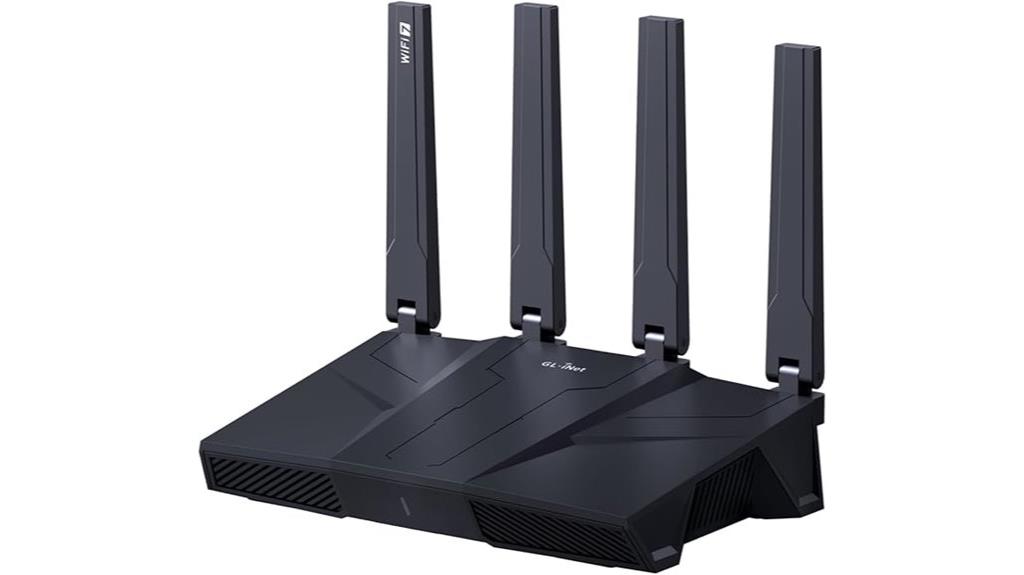
For anyone seeking ultra-fast, reliable Wi-Fi coverage for large homes or busy offices, the GL.iNet GL-BE9300 (Flint 3) Tri-Band WiFi 7 Router stands out with speeds up to 9 Gbps and support for over 100 devices. It features advanced Wi-Fi 7 technology, including MLO, enhanced OFDMA, and 4K QAM, ensuring low latency and stable performance in high-density environments. With a coverage of up to 2,000 sq ft, easy setup, and robust security options like VPN support and parental controls, this router delivers both speed and peace of mind. Its user-friendly interface makes managing multiple devices straightforward, perfect for demanding digital households or offices.
Best For: households or offices requiring ultra-fast, reliable Wi-Fi coverage for multiple devices, streaming, gaming, and remote work in large spaces.
Pros:
- Supports Wi-Fi 7 with speeds up to 9 Gbps and low latency for seamless high-bandwidth activities.
- Handles over 100 devices simultaneously, ideal for busy households or offices.
- Features advanced technology like MLO, enhanced OFDMA, and 4K QAM for stable, high-density performance.
Cons:
- May require firmware updates for optimal performance and security.
- Larger size and weight could be less convenient for portable use or small spaces.
- Price point may be higher compared to previous Wi-Fi standards and other routers with fewer features.
ASUS ROG Rapture GT-BE98 PRO Gaming Router
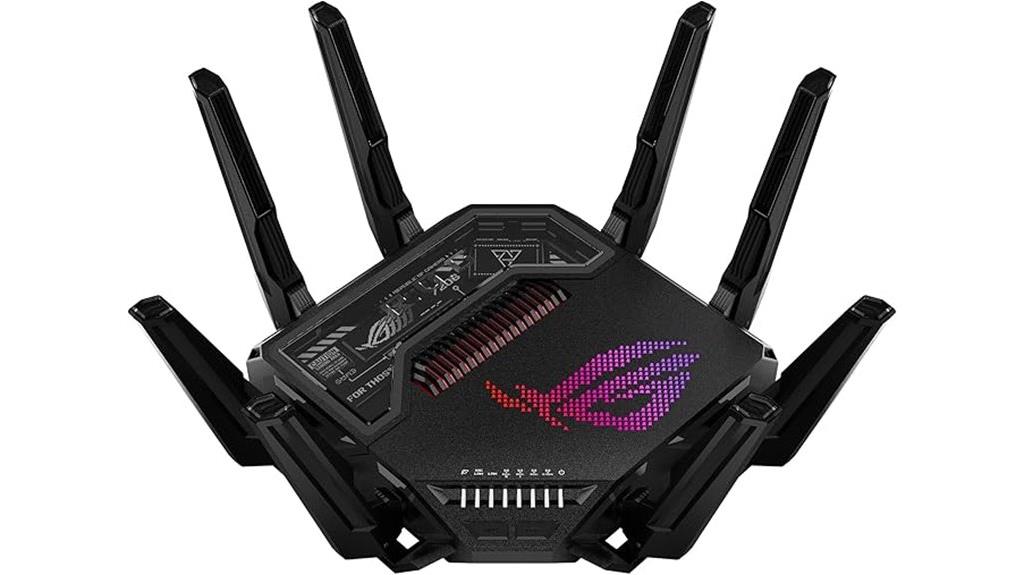
Gamers seeking lightning-fast, stable connections will find the ASUS ROG Rapture GT-BE98 PRO an ideal choice, thanks to its support for WiFi 7’s cutting-edge Multi-link Operation technology. This quad-band router delivers speeds up to 30 Gbps by linking multiple bands simultaneously, ensuring smooth gameplay and heavy data transfer. External dual-feeding antennas boost coverage and signal strength, while features like Triple-Level Game Acceleration and Mobile Game Mode optimize traffic for gaming. With dual 10G ports and quad 2.5G ports, it offers flexible wired connectivity. Its sleek design, combined with robust performance and security features, makes it perfect for serious gamers seeking a future-proof, high-capacity network solution.
Best For: serious gamers and users requiring ultra-fast, stable, and high-capacity internet connections for gaming, streaming, and heavy data tasks.
Pros:
- Supports WiFi 7 with speeds up to 30 Gbps and Multi-link Operation for optimal performance
- Features dual 10G ports and quad 2.5G ports for versatile, high-speed wired connectivity
- External antennas enhance coverage and signal strength for widespread, reliable coverage
Cons:
- The advanced features and high performance may come at a premium price point
- Actual speeds and coverage can vary based on environmental factors and building materials
- Large size and weight may require ample space and proper placement for optimal performance
Amazon eero 7 Dual-Band Mesh Wi-Fi 7 Router
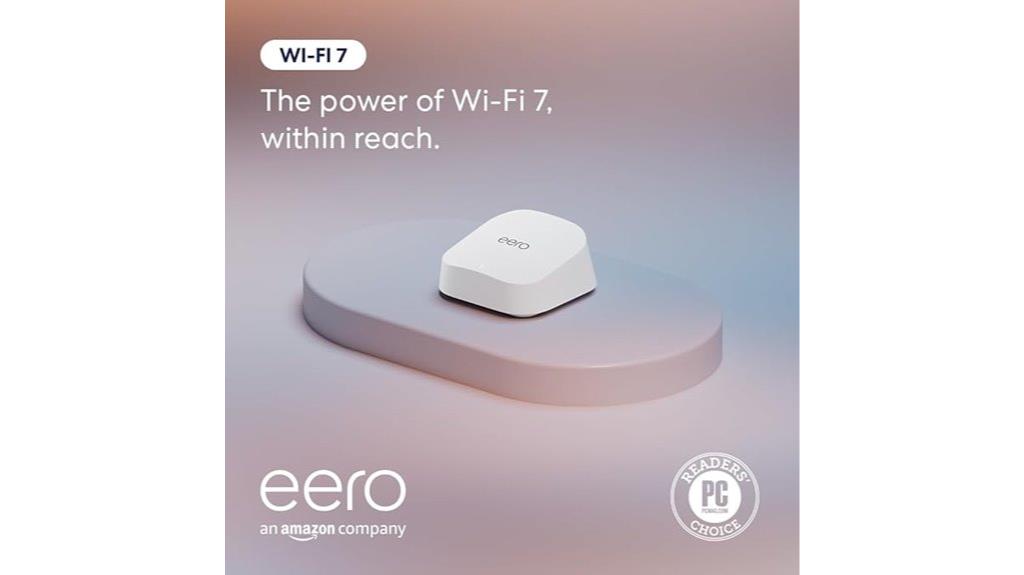
If you’re looking for a reliable Wi-Fi 7 router that can handle multiple devices and deliver high-speed internet throughout your home, the Amazon eero 7 Dual-Band Mesh Wi-Fi 7 Router is an excellent choice. Supporting internet plans up to 2.5 Gbps and covering up to 2,000 sq. ft., it supports over 120 devices seamlessly. Its Wi-Fi 7 technology with multi-link operation provides speeds up to 1.8 Gbps. Easy to expand and compatible with previous eero models, it offers robust security, smart home integration, and user-friendly management through the eero app. This router guarantees fast, reliable, and future-proof connectivity for any household.
Best For: households and small offices seeking a high-speed, reliable, and expandable Wi-Fi 7 network capable of supporting many devices simultaneously.
Pros:
- Supports internet plans up to 2.5 Gbps with extensive coverage of up to 2,000 sq. ft.
- Seamlessly supports over 120 devices with advanced Wi-Fi 7 technology and multi-link operation.
- Easy to expand and integrates well with existing eero networks and smart home devices.
Cons:
- Requires a supported mobile device and internet service setup, which may be a hurdle for some users.
- Limited to compatible devices for full smart home protocol integration like Zigbee and Matter.
- May be more expensive compared to traditional routers without Wi-Fi 7 or mesh capabilities.
TP-Link Deco BE25 Dual-Band WiFi 7 Mesh System (3-Pack)

The TP-Link Deco BE25 Dual-Band WiFi 7 Mesh System (3-Pack) stands out for its exceptional coverage and ability to support over 150 devices simultaneously without sacrificing performance. With WiFi 7 technology, it delivers up to 5 Gbps speeds on the 5GHz band and robust coverage of up to 6,600 square feet. Equipped with four high-gain antennas and support for wired and wireless backhaul, it ensures a stable, broad connection. Its advanced features include Multi-Link Operation, AI Roaming, and compatibility with smart home devices, making it ideal for busy households and high-demand environments. Plus, the security features keep your network safe and private.
Best For: households and small offices seeking high-speed, reliable WiFi coverage with support for numerous devices and smart home integration.
Pros:
- Supports WiFi 7 with speeds up to 5 Gbps and extensive coverage of 6,600 sq. ft.
- Handles over 150 devices simultaneously without performance loss.
- Features advanced security and seamless mesh networking with AI Roaming.
Cons:
- Requires a modem for internet connection, adding to initial setup.
- May be overkill for users with minimal device needs or smaller spaces.
- Higher price point compared to traditional WiFi systems with less advanced features.
ASUS RT-BE92U BE9700 Tri-Band WiFi 7 Router
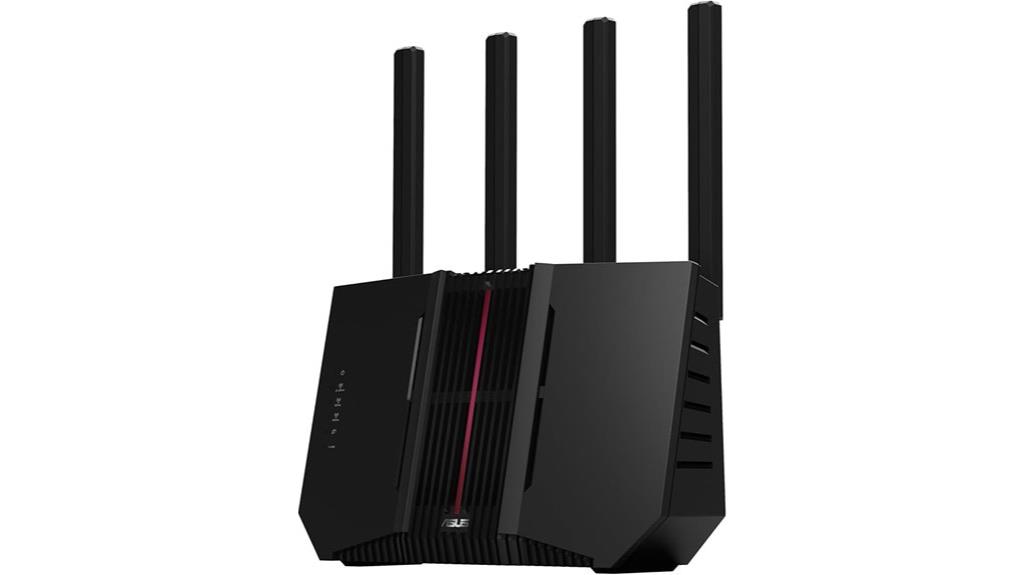
For those seeking a future-proof Wi-Fi solution that balances speed, stability, and extensive networking features, the ASUS RT-BE92U BE9700 Tri-Band WiFi 7 Router stands out. It leverages WiFi 7 technology, offering speeds up to 9700 Mbps with 6 GHz band channels, 4096-QAM, and Multi-link Operation for better capacity and reliability. Its tri-band setup supports simultaneous connections, while AI-boosted Smart AiMesh extends coverage. With versatile WAN options, a USB port for 4G/5G tethering, and a thorough security suite, this router is designed for high performance and future readiness. Its hardware supports up to 2750 square feet, making it ideal for demanding homes and small businesses.
Best For: those seeking a high-performance, future-proof Wi-Fi 7 router with extensive networking features suitable for demanding homes and small businesses.
Pros:
- Supports WiFi 7 with speeds up to 9700 Mbps, ensuring fast and stable connections.
- Tri-band setup with Multi-link Operation and AI-boosted Smart AiMesh for optimal coverage and network stability.
- Versatile WAN options, including USB tethering and comprehensive security features with subscription-free AiProtection Pro.
Cons:
- Slightly heavier and larger than some competing routers, which may require more space.
- Customer ratings are moderate at 3.8/5 stars, indicating some users may experience setup or performance issues.
- Higher price point due to advanced features, which might not be necessary for basic home use.
Factors to Consider When Choosing Wi-Fi 7 Routers
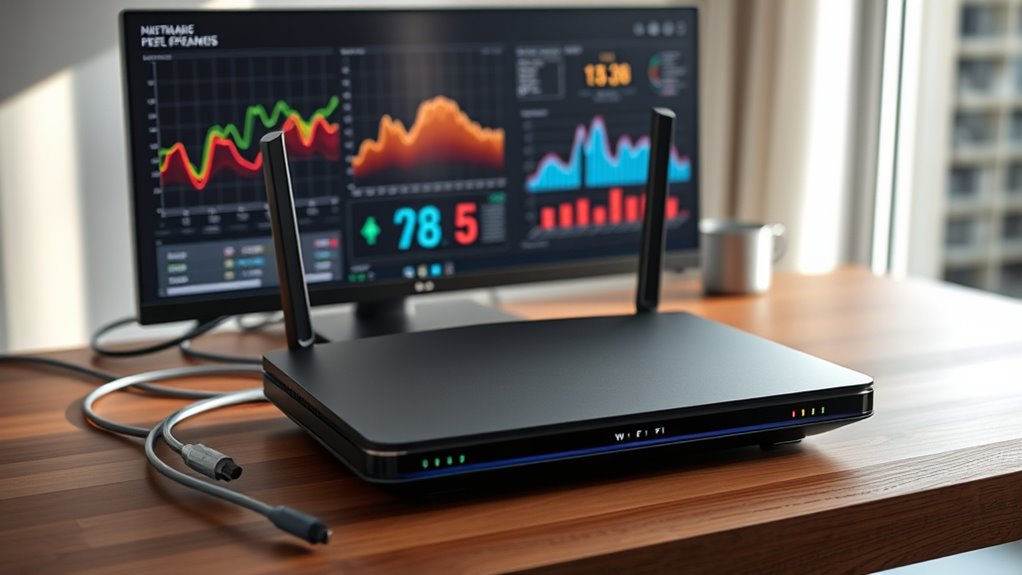
When choosing a Wi-Fi 7 router, I consider factors like speed and throughput to guarantee fast, reliable connections. Coverage area and device compatibility are also essential so I can connect all my gadgets seamlessly. Additionally, I look at security features and wired options to keep my network safe and flexible for various setups.
Speed and Throughput
Have you ever wondered how Wi-Fi 7 routers achieve lightning-fast speeds and reliable connections? They use multi-link operation (MLO), which combines multiple bands for increased speed and stability. These routers support theoretical maximum speeds up to 30 Gbps, a huge leap from earlier standards. Advanced modulation techniques like 4K-QAM and wider channel bandwidths of up to 320 MHz boost throughput considerably. The number of spatial streams and multi-user MIMO technology also play vital roles, allowing simultaneous data transfers to multiple devices. However, actual network speed depends on both the router’s hardware and your ISP’s internet quality. So, when choosing a Wi-Fi 7 router, look for those with high-capacity hardware features that can handle this potential for blazing-fast speeds.
Coverage Area
Speed and throughput are essential, but without adequate coverage, those fast connections can fall short. The coverage area of a Wi-Fi 7 router determines how many square feet it can reliably serve, impacting overall performance. Larger spaces often need routers with multiple high-gain antennas and beamforming technology to maintain strong signals throughout. For extensive homes or offices, mesh systems or repeaters can extend coverage seamlessly, preventing dead zones. The router’s placement also matters—a central location maximizes signal distribution. Additionally, the number of connected devices and the building’s layout influence how much coverage you need. Choosing a router that matches your space ensures consistent, high-quality Wi-Fi across your entire home or workspace. Proper coverage setup helps you make the most of your Wi-Fi 7 network.
Device Compatibility
Choosing a Wi-Fi 7 router that fits your needs requires paying close attention to device compatibility. First, confirm the router supports the latest Wi-Fi 7 (802.11be) standard to future-proof your network and connect with upcoming devices. It’s also important to check if it’s backward compatible with Wi-Fi 6 and Wi-Fi 5, so your existing gadgets continue working smoothly. Consider the number of supported SSIDs and device connections—this is crucial for managing multiple users and smart home devices. Additionally, verify that the router’s security protocols, like WPA3, are compatible with your devices for maximum protection. Finally, see if it supports advanced features such as Multi-Link Operation (MLO) or Multi-RUs, which can boost performance for compatible devices.
Security Features
When selecting a Wi-Fi 7 router, security features should be at the top of your list to protect your network and devices. Look for routers supporting WPA3 encryption, the latest standard offering stronger protection against hacking. A thorough security suite like TP-Link HomeShield or NETGEAR Armor is vital for real-time threat detection and defense. Features such as device management, parental controls, and IoT segmentation help you control access and isolate vulnerable devices. Automatic firmware updates are essential—they patch security flaws and keep your router resilient. If you need secure remote access, choose routers that support VPN clients and servers. Prioritizing these security features ensures your network remains safe and future-proof against evolving cyber threats.
Wired Connectivity Options
Since wired connectivity is vital for stable and high-performance networks, it’s important to contemplate the types and number of ports a Wi-Fi 7 router offers. Many models feature multi-gigabit ports, such as 2.5 Gbps, 5 Gbps, or even 10 Gbps, supporting fast wired connections for devices like gaming PCs, smart TVs, and network storage. A 10 Gbps WAN port is essential for future-proofing, especially when paired with multi-gig fiber or cable modems. Multiple LAN ports, including multi-Gig options, guarantee you can connect several wired devices simultaneously. Additionally, USB ports (USB 3.0 or higher) allow sharing storage or printers across your network. Wired backhaul options, like Ethernet ports connecting mesh nodes, help maintain ideal performance and reduce wireless congestion.
Future-Proof Technologies
As we look toward the future of home networking, staying ahead means investing in routers that support advanced technologies like Multi-Link Operation (MLO) and Multi-RUs. These features maximize bandwidth and stability, ensuring your network can handle the growing demands of new devices. Future-proof Wi-Fi 7 routers also utilize 4K-QAM modulation and 320 MHz channels, dramatically boosting data capacity and speeds over previous standards. Compatibility with multi-gigabit internet plans and multi-gig ports prepares your setup for ultra-fast fiber and cable connections. Additionally, seamless integration with mesh systems and IoT devices means expanded coverage and smarter home networks. Robust security features and ongoing firmware updates are essential for safeguarding against evolving threats, helping your network stay secure and compatible long-term.
Management and Setup
Choosing the right Wi-Fi 7 router starts with evaluating how easily it can be set up and managed. Most models offer quick setup via dedicated mobile apps or web interfaces, making initial configuration straightforward. Features like AI-based network management, automatic channel selection, and device prioritization help optimize performance without hassle. Support for mesh systems and seamless roaming allows for flexible network expansion and smooth device handoffs across coverage areas. Security is also vital; compatibility with WPA3 and integrated security tools protect your network during setup and daily use. User-friendly management tools, accessible through smartphone apps or web portals, enable remote monitoring, parental controls, and device management. These features ensure you spend less time configuring and more time enjoying a fast, stable Wi-Fi experience.
Frequently Asked Questions
How Does Wi-Fi 7 Improve Latency Over Previous Standards?
Wi-Fi 7 markedly reduces latency compared to previous standards by using advanced technologies like 4096-QAM modulation and multi-link operation, which allow data to transfer faster and more efficiently. I’ve noticed smoother gaming, quicker video calls, and less lag overall. These improvements mean I experience more responsive connections, especially in busy environments, making Wi-Fi 7 ideal for real-time applications and future-proofing my network for emerging tech.
Can Existing Devices Fully Utilize Wi-Fi 7 Speeds?
Existing devices generally can’t fully utilize Wi-Fi 7 speeds yet. While the new standard offers incredible bandwidth and lower latency, most current gadgets are designed for earlier Wi-Fi versions. I recommend upgrading your devices if you want to experience Wi-Fi 7’s full potential. Until then, Wi-Fi 7 routers will still improve your network’s reliability and speed for compatible devices, making your overall experience smoother.
What Security Features Are Standard in Wi-Fi 7 Routers?
Wi-Fi 7 routers come with robust security features that keep your network safe from threats. I’ve seen these routers block malware and unauthorized access with advanced WPA3 encryption, integrated VPN support, and automatic firmware updates. They also include features like network segmentation and parental controls. It’s like having a high-tech security system protecting your digital home, giving you peace of mind while enjoying lightning-fast internet speeds.
How Future-Proof Are Wi-Fi 7 Routers for Upcoming Technologies?
Wi-Fi 7 routers are highly future-proof because they support the latest standards like 16 Gbps speeds and enhanced MU-MIMO, which will handle upcoming tech demands smoothly. I believe they’re ready for innovations like augmented reality, smart homes, and 8K streaming. As technology evolves, these routers will adapt better than older models, making them a solid investment for staying connected and ahead of the curve.
Do Wi-Fi 7 Routers Support Seamless Roaming Across Multiple Access Points?
Imagine walking through your home, and your device effortlessly glides from room to room without interruption—that’s what Wi-Fi 7 routers support. They do support seamless roaming across multiple access points, using advanced standards like IEEE 802.11k, v, and r. This means your connection stays stable and smooth as you move around, making your experience more reliable and enjoyable without annoying drops or lag.
Conclusion
Choosing the right Wi-Fi 7 router can feel like finding a needle in a haystack, but with the options I’ve highlighted, you’re well on your way. Whether you need speed, reliability, or future-proofing, there’s a perfect fit for you. Remember, it’s better to invest now than to be caught between a rock and a hard place later. So, pick smart, and enjoy seamless connectivity that keeps you ahead of the game.
